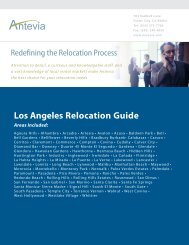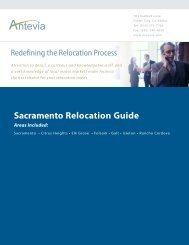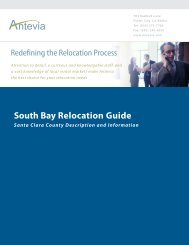San Francisco Relocation Guide - Antevia
San Francisco Relocation Guide - Antevia
San Francisco Relocation Guide - Antevia
You also want an ePaper? Increase the reach of your titles
YUMPU automatically turns print PDFs into web optimized ePapers that Google loves.
Chestnut Street, looking eastward from Scott<br />
Cow Hollow, Russian Hill, Pacific Heights, and the Presidio bound the Marina District to<br />
the south, east and west.<br />
ZIP Code: 94123<br />
Population (2000[1]): 22,903<br />
Housing units: 14,851<br />
Land area: 1.0 mile² (2.6 km²)<br />
Water area: zero<br />
White population: 19814<br />
Black population: 117<br />
American Indian population: 34<br />
Asian population: 2189<br />
Native Hawaiian and Other Pacific Islander population: 21<br />
Some other race population: 240<br />
Two or more races population: 488<br />
Urban population: 22903<br />
Rural population: 0<br />
Median age: 35.3<br />
Average household size: 1.61<br />
Median household income (1999): $84,710<br />
History<br />
On the bay north of Cow Hollow, a sea wall was erected parallel to the shoreline, and the<br />
marshland in between was filled with sand pumped up from the bottom of the ocean.<br />
Dredging left enough deep water for the creation of the St Francis and Golden Gate<br />
Yacht Clubs, which occupy prestigious spots at the foot of Baker Street. Slightly to the<br />
east is Marina Green, a large stretch of turf frequented for the most part by runners. A<br />
less strenuous exercise is the Golden Gate Promenade that runs parallel to Marina<br />
Boulevard, continuing a couple of miles further before reaching the eponymous bridge. A<br />
massive landscaping effort recreated natural marshlands and tidepools at Crissy Field, the<br />
long swath of land and tidal marsh that reaches from Marina Green to the bridge.<br />
The creation of the Marina District is shrouded in myth and folklore. Many people claim<br />
that the area was created out of the rubble dumped into the Bay in the period after the<br />
great quake of 1906. Photographs of the Marina District as recently as 1912 show most of<br />
the area still as being in the bay, posing the question of why it would take six years for<br />
the rubble to be dumped to form the Marina. In 1885, Filbert Street was still the old<br />
Presidio Road. North onto Buchanan Street toward the bay, two blocks away, Lombard<br />
Street was sand dunes, about 35 feet higher than present. The shoreline was already being<br />
pushed northward by industrial power companies. The area now covered by Moscone<br />
Recreation Center and Marina Middle School was Lobos Square, a flat spot where the







